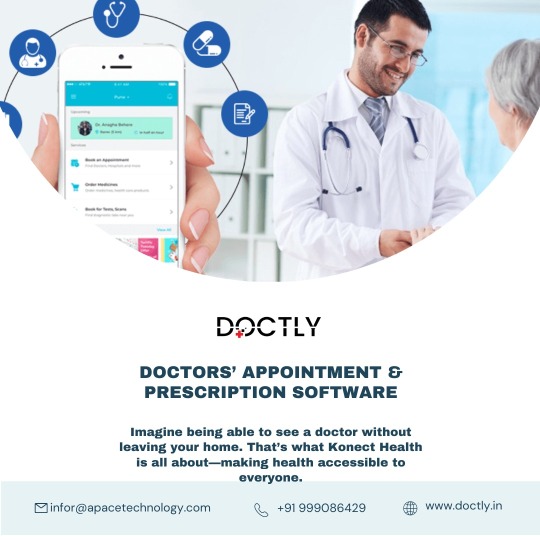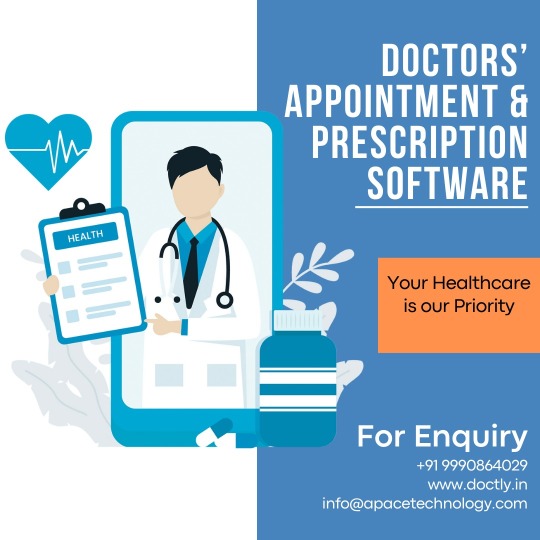Don't wanna be here? Send us removal request.
Text
Doctors’ appointment & prescription software

Simplifies prescription and appointments, helping you to manage patients & chambers in a smart way. Create your first prescription in less than 60 seconds.
The better way to manage your chambers, prescriptions, appointments & patients
Using Doctly account you can easily manage chamber wise prescriptions, patients, appointments and many more features.
Online Consultation
Using Zoom online consultation patients can make a live video meeting with the experts and get treatment & advices from them. Also, doctors can set a fee for the online consultation and receive payments from patients using PayPal and stripe
Online Appointment Booking
Patients can book their online or offline appointments with their experts in specific date and time. Doctors can manage all bookings from their portals and patients can see the status from patient portal.
Advanced & Super-easy Prescription System
We have a automated, powerful and super easy onload prescription system that will help the doctor’s to create & print their prescriptions within a minute.
Doctly is a complete doctor’s appointment & prescription Software that gives your customers the ability to create and manage staffs, prescriptions, patients, drugs, advises, investigations, appointments etc. Users also can create multiple chambers & assign staffs so they can easily keep track of their chambers, patients & appointments in one platform.
Book your appointment online with Doctly. Get the best medical consultation & treatment with the best doctors.

There are various software applications and platforms available to help manage doctors' appointments and prescriptions efficiently. These software solutions aim to streamline the process, reduce paperwork, enhance communication, and improve overall patient care. Here are a few examples of commonly used doctors' appointment and prescription software:
Electronic Health Record (EHR) Systems: EHR systems like Epic, Cerner, and Allscripts offer comprehensive solutions that include appointment scheduling, patient records management, prescription management, and billing. They allow healthcare providers to maintain accurate and up-to-date patient information, manage appointments, and generate prescriptions electronically.
Practice Management Software: Practice management software such as Kareo, Practice Fusion, and Athenahealth assist in scheduling appointments, managing patient records, generating prescriptions, and handling billing and insurance claims. These tools often integrate with EHR systems to provide a seamless workflow for healthcare providers.
Appointment Booking Systems: Solutions like Zocdoc, Doctolib, and Practo focus primarily on appointment scheduling and management. They enable patients to book appointments online, provide real-time availability of doctors, and send automated reminders. These systems often integrate with EHR systems for seamless data exchange.
E-Prescribing Software: Dedicated e-prescribing platforms like Surescripts, DrFirst, and Practice Fusion's eRx offer features specific to managing prescriptions electronically. They allow physicians to electronically send prescriptions to pharmacies, check for drug interactions, and access patient medication history.
Telemedicine Platforms: With the rise of telehealth services, telemedicine platforms like Amwell, Doxy.me, and Zoom for Healthcare have become popular. These platforms facilitate virtual consultations, including appointment scheduling, video conferencing, and electronic prescriptions.
It's important to note that the availability and specific features of these software solutions may vary, so it's advisable to research and evaluate multiple options to find the one that best suits your needs and the requirements of your healthcare practice.
Telemedicine has become increasingly important in recent years due to several reasons:
Improved access to healthcare: Telemedicine allows patients to consult with healthcare professionals remotely, eliminating geographical barriers and improving access to medical care. This is particularly beneficial for individuals living in rural or underserved areas where healthcare facilities may be limited.
Convenience and flexibility: Telemedicine provides convenience to patients by eliminating the need for travel and long waiting times at clinics or hospitals. Patients can have virtual consultations from the comfort of their homes or workplaces, saving time and reducing the burden of scheduling appointments.
Timely medical assistance: Telemedicine enables timely medical assistance, especially for urgent or time-sensitive cases. Patients can receive quick medical advice, diagnosis, and treatment recommendations without the need to wait for in-person appointments.
Continuity of care: Telemedicine facilitates continuous and ongoing healthcare management. Patients can have follow-up visits, monitor chronic conditions, and receive prescription refills through virtual consultations, ensuring they receive consistent care even if they cannot physically visit a healthcare facility.
Cost-effective healthcare delivery: Telemedicine has the potential to reduce healthcare costs for patients. It eliminates travel expenses, reduces hospital readmissions, and decreases the overall burden on the healthcare system. It can also be a cost-effective option for healthcare providers, enabling them to reach more patients without the need for extensive infrastructure.
Remote monitoring and health tracking: Telemedicine allows for remote monitoring of patients' vital signs, health conditions, and progress. With the help of wearable devices and remote monitoring tools, healthcare providers can gather real-time data and make informed decisions about patient care.
Outbreaks and emergencies: During pandemics or other health emergencies, telemedicine plays a critical role in minimizing the spread of infectious diseases. It helps in triaging patients, providing initial assessments, and guiding them on appropriate next steps, reducing the burden on hospitals and preventing overcrowding.
Overall, telemedicine offers a range of benefits that address challenges in healthcare delivery, improve access to medical services, and enhance patient outcomes, making it increasingly necessary in today's healthcare landscape.
1 note
·
View note